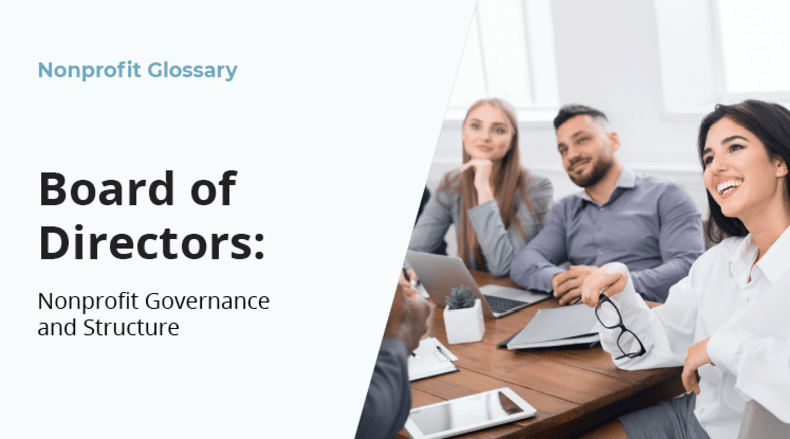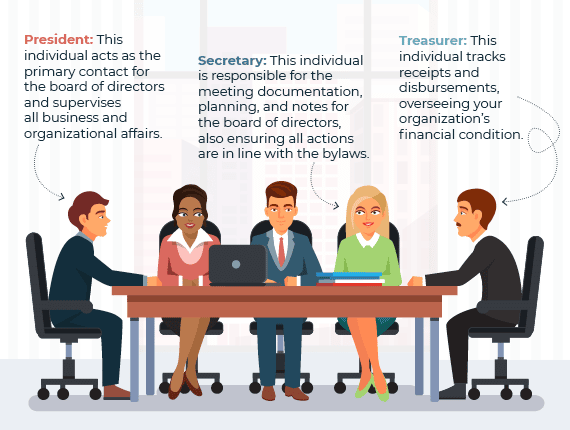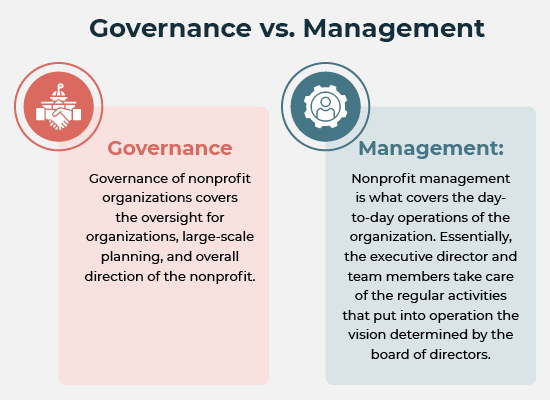Board of Directors for Nonprofits

Regardless of the type of mission or nonprofit status, all types of organizations require clear direction and oversight. This oversight is often provided by the board of directors, the governing body of individuals who have varying skills and a desire to see the organization succeed. Traditionally, nonprofits chose the most well-connected and often wealthy individuals to serve on the board, believing that those connections and wealth would translate into more connections and resources for the organization.
However, over time, many organizations have discovered the importance of looking for individuals with more than just connections in mind. Organizations should want to stack their board with passionate individuals who really want to see the organization succeed.
When you just look for a well-connected individual who might be able to score your organization major donations, you fail to address some key questions like: Does this board member want my organization to succeed? Will they work hard to govern this organization? Do I trust the decisions made by this board member?
Essentially, you want to choose board members who will be driven to help your organization pursue its mission.
To help you choose the best board members and maximize your resources regarding your board, we’ll start at the very beginning: What is a board of directors?

What is a nonprofit board of directors?
A board of directors, also known as a nonprofit board, is the governing body of a nonprofit. The members of a nonprofit board focus on the high-level strategy, oversight, and accountability of the organization. This contrasts with employees or managers who oversee the day-to-day operations of the nonprofit.
The individuals who make up your board of directors are responsible for making key decisions that address the organization’s mission, strategy, and goals. They aim to address the public’s interest through the organization’s work and act as the legal voice for the organization.
While nonprofit boards typically range anywhere from three to fifty members, there are a handful of roles and positions that are almost always assigned to different members of the board.
Here are three common officer positions that make up the board’s leadership:

- President: The president of your board of directors is the head of your nonprofit board. They preside at board meetings and create meeting agendas. This individual also supervises all of the business affairs of the board and acts as the primary contact for the group. While this individual may serve as the executive director of the organization, the role is very different. Your executive director manages the daily activities of the organization while your board president is in charge of governance.
- Secretary: The secretary of your board of directors is responsible for distributing your meeting agenda and recording the minutes of the meeting. They’ll also make sure all documentation is filed and organized correctly for easy access at a later date and ensure all actions are in line with the organization’s bylaws.
- Treasurer: The treasurer on your board of directors is responsible for overseeing your organization’s financial condition by keeping track of receipts and disbursements. This person might be a part of your finance team, or at least in frequent contact with them. If you are required to conduct a financial audit, your treasurer will present the findings.
Generally, these members of your board of directors (and the team as a whole) meet a few times throughout the year to make decisions and ensure the organization is on track. The law varies state by state as to how often the entire board of directors should meet, but most require them to meet at least once every year with all members in attendance.

Why are nonprofit boards important?
As we mentioned earlier, your nonprofit board of directors is in charge of the governance of your organization while your executive director and team members handle the day-to-day operations. But what is the difference?

- Governance: Governance of nonprofit organizations covers the oversight for organizations, large-scale planning, and overall direction of the nonprofit.
- Management: Nonprofit management is what covers the day-to-day operations of the organization. Essentially, the executive director and team members take care of the regular activities that put the vision determined by the board of directors into operation.
Nonprofits need a board of directors for a variety of reasons. Not only is the members’ wealth of knowledge and experience invaluable to the organization, but they are also necessary for essential tasks like applying for bank accounts, filing annual reports, and making important purchases.
Additionally, they act as the guiding voice for large decisions like approving annual budgets, borrowing money, and setting plans for major growth or reorganization.
When you’re recruiting members to serve on your board of directors, it will behoove your organization to choose visionaries—people who have big picture ideas for your organization and can identify how to get there. These should be the people leading the race to drive important decisions and the direction of your organization. Meanwhile, your staff members should be composed of the people who can accomplish the daily activities and take actions to make the vision possible.
Of course, this explanation oversimplifies the concept of recruitment. In the next section, we’ll take a deeper dive into the recruitment process for your organization’s board members.

How do nonprofits recruit board members?
First and foremost, there are no legal guidelines in place determining who can serve on the board of a nonprofit. This means it’s entirely up to your organization who will be the best individual for the position. That said, there are a few things organizations should consider when recruiting board members.
The most important quality to look for in a good board member is a passion and dedication to your mission. When your board members are driven by your mission, they’ll be more likely to make the decisions and have the motivation to continue pushing that mission forward.
With the foundation of your mission in mind, your organization can then start considering the four C’s of recruitment to find the best people to serve your nonprofit:
- Culture: The culture of your organization all comes back to a few essential core values that your organization represents. These values are what is considered right and good for your organization. By ensuring you recruit members to your board who also hold and respect the core values of your organization, they’ll carry your organization’s culture into the board room.
- Character: Every day, we make judgments about people based on their actions. The character of the people you choose to serve will come back as a reflection of your organization as a whole. Choosing caring, respectful, and kind people to be on your board of directors will show the community that your organization also holds those characteristics.
- Competence: When you choose members for your board of directors, you’ll need to be sure that they’re competent in the areas in which they need to have competence. Of course, they need to be able to learn and retain information from meetings and about your organization. However, they’ll also need high emotional aptitude to perceive, control, and express emotions, allowing them to be adaptable to different situations at the organization. In addition, your members should be subtle thinkers that come up with simple solutions to complicated problems.
- Connections: In the past, nonprofits recruited board members simply because they had highly affluent friends. However, now that’s not the only type of connection you should be interested in. While affluent connections are always helpful, you should also consider board members with connections who have a passion for the mission, have a connection to those you serve, and who can help you better serve the community.
When looking for these individuals, we recommend avoiding recruiting paid employees within your organization. While they may fulfill all of our above recommendations, paid employees may experience a conflict of interest in serving both roles. Plus, they could bite off more than they could chew. If you’re still unsure of who to choose, look for someone with some businesses in business affairs.
You can look for engaged members of your community by participating in a board-match program in your area. These programs host networking events that allow nonprofits the opportunity to meet qualified board members from a wide range of backgrounds. Or, you can utilize tools like LinkedIn’s Board Member Connect to start looking for potential board members. Because LinkedIn allows users to indicate whether they are interested in serving on a nonprofit board, it makes it easy for organizations to find candidates who fit their criteria. Then, you can conduct additional research, analyses, and interviews to see who will be the best fit.

How are nonprofit boards structured?
While new nonprofits are left to structure their board from scratch, existing organizations may need to restructure their boards as they grow and expand their team. While you already learned about the different officers who serve on your nonprofit board of directors, they don’t make up the entire group.
Most of the time, nonprofit boards of directors are structured with a number of committees. These committees allow boards to tackle nominations and governance, finances and risk, and executive decisions. A current trend in the sector is to have three committees on the board. This committee structure is easy and manageable, making it simple to streamline tasks.
The following committees generally make up this three-part structure:
- Governance Committee: The Governance Committee recruits new board members and determines the performance of the board as a unit. Essentially, this is the committee that governs and oversees various board activities.
- Internal Affairs Committee: The Internal Affairs Committee is responsible for the finances of the organization, including budget review, capital acquisitions, personnel, and other such activities.
- External Affairs Committee: The External Affairs Committee is in charge of communications, marketing, and PR with the community. This committee is also in charge of fundraising, an essential part of board engagement.
When other activities crop up and your board of directors needs to accomplish other various tasks, you might set up additional task forces. These task forces might cover projects related to communications, programs, fundraising, marketing, compensation, or other topics.

What are the responsibilities of a nonprofit board of directors?
As a whole, when people become board members for nonprofits, they are expected to take on a number of responsibilities for the organization. Essentially, there are four different responsibilities of nonprofit boards of directors: legal and fiduciary responsibilities, board meeting attendance, executive compensation decisions, and committee service.
Legal and fiduciary responsibilities
Your nonprofit board of directors is the legal governing body of the nonprofit. This means they may need to make some legal decisions concerning the organization. Your board needs to be aware of all of the legal requirements that apply to the organization and oversee that those requirements are met.
For example, your board of directors should be aware of the repercussions associated with overpaying individuals at the organization or participating in political lobbying. While board members probably won’t be the ones to actually submit your tax forms, they’re in charge of ensuring that they’re completed annually as well.
Board meeting attendance
When the board of directors meets as a group, they should be able to depend on one another to attend and be prepared to contribute. Everyone should review the agenda ahead of time and participate in the decisions made.
If an individual agrees to be on the board of your organization, you should be able to count on them as a reliable contributor. How could you do that if they don’t attend meetings?
Executive compensation decisions
Nonprofit organizations are considered nonprofits because their funding is reinvested back into the organization and its mission. This means that your nonprofit’s executive director has a set compensation that must be set by someone. Would it be fair for them to set their salary themselves? Probably not.
That’s where the nonprofit board of directors comes in. As the governing entity of your organization, your organization’s board of directors sets the compensation of the executive director to ensure everything is fair and there’s oversight on the matter.
Committee service
Your board members should be engaged with your organization and the various projects and programs you’re implementing. This means that they should participate in the various activities and decisions by serving on committees.
Try to pair each board member with the committee that best interests them. This will ensure that they’re engaged with the committee’s activities and will help maintain motivation to serve that purpose well.

Bottom Line
Few things are more important to the health and sustainability of a nonprofit than its board of directors. A board of directors leads organizations through important tasks and decisions.
Therefore, it’s important that you, as a nonprofit professional, understand the purpose of your nonprofit board, recruit the best possible board members, and help ensure everyone prizes the mission and vision of the mission.
Related Resources
- Nonprofit Quarterly: Nonprofit Board Responsibilities: The Basics
- 501c3.org: Nonprofit Board Members – How To Choose Wisely
- National Council of Nonprofits: Finding The Right Board Members For Your Nonprofit